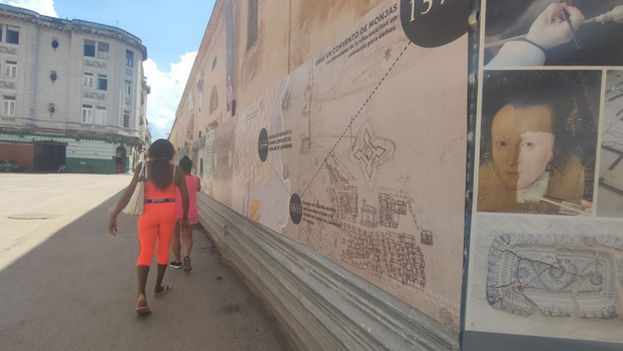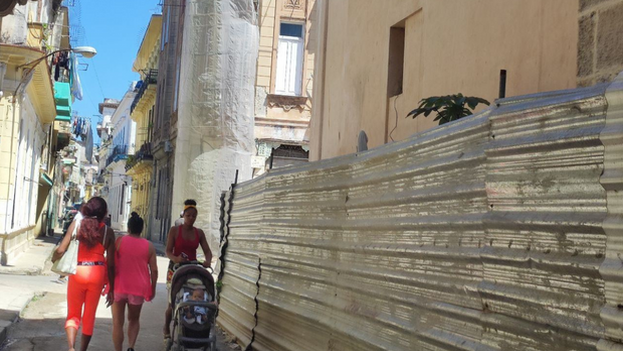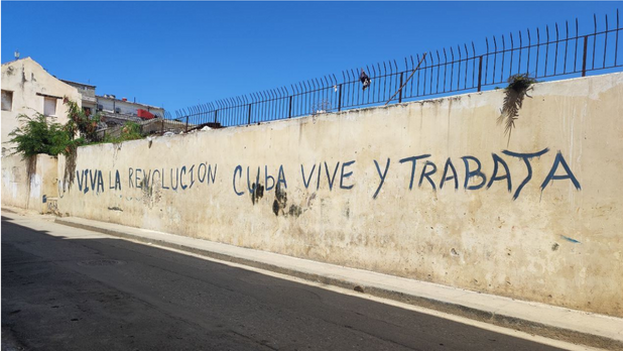
![]() 14ymedio, Natalia López Moya, Havana, 21 September 2022 — Julita is 57 years old and sells avocados next to the Santa Clara de Asís Convent, the oldest cloister in Havana which is in the middle of a capital restoration to return it to its former splendor. A few meters from its painted yellow walls the residents of the area dream that the investment will be enough to also renovate a neighborhood sunk in housing deterioration and crisis.
14ymedio, Natalia López Moya, Havana, 21 September 2022 — Julita is 57 years old and sells avocados next to the Santa Clara de Asís Convent, the oldest cloister in Havana which is in the middle of a capital restoration to return it to its former splendor. A few meters from its painted yellow walls the residents of the area dream that the investment will be enough to also renovate a neighborhood sunk in housing deterioration and crisis.
“Until now, they haven’t told us anything that they’re also going to repair some nearby houses, not even the potholed streets that are quite cracked,” a resident of Calle Sol, who was born in the tenement where she and about twenty families now live, with explains to 14ymedio. “Since 1965, when my mother brought me into this world, the people on this lot have been waiting for their little dwellings to be fixed up.”
Across the entrance where Julita offers her avocados – “some are ready to be eaten today and others tomorrow” – rises the imposing structure of the convent that occupies a huge block outlined by the emblematic Old Havana streets: Habana, Cuba, Sol and Luz. The wall that surrounds the garden and the rest of the facades offer little information about the works that are taking place inside.
Only one entrance for vehicles allows you to browse and talk with an animated custodian who declares that the works “are already halfway through” and that they are in the hands of a Cuban cooperative, whose name he avoids giving. The view from that location does not help much to get an idea of the repair process, since there are no workers, no hustle and bustle of trucks with materials, and, other than the bored security employee in his booth, no other people can be seen.
There was “a lot of movement in the neighborhood” a few days ago when the future headquarters of the College of Arts and Crafts of Santa Clara was visited by the ambassador of the European Union in Cuba
“It is going to be a school and it will be ready in 2024,” explains the man at the top of his voice several meters from a fence that encloses the entrance to the place. But a walk around the block is enough to conclude that the prognosis may be rather optimistic, because only the part of the building that faces Havana Street shows signs of being restored. The rest still shows the scars that time, laziness and the natural elements left on the convent.
Julita and her neighbors saw “a lot of movement in the neighborhood” a few days ago when the future headquarters of the College of Arts and Crafts of Santa Clara was visited by the ambassador of the European Union in Cuba, Isabel Brilhante, according to the Spanish agency EFE. “We realized that someone important was coming because the area was filled with policemen and they even picked up the garbage. Then the diplomatic cars left and everything went back to the way it was before.”
The work, a project between the Office of the Historian of Havana, the UNESCO regional office for Culture, the EU and the Italian Agency for Cooperation, seeks to create a space for training in the arts and restoration trades in Cuba and the Caribbean region. But the residents in the vicinity have their doubts about the final destination of a construction that has marked the lives of Havana’s residents in its more than four centuries of history.
Raydel is sitting in his pedicab under the shadow that this Tuesday afternoon was projected by the metal fence surrounding the main entrance of the building on Havana Street. “There are already several schools dedicated to this restoration, there is even the San Gerónimo University College in Havana and a workshop school. Why build another school?” he questions. “This neighborhood needs a cultural, recreational space for children and young people.”

With its three cloisters and a room that serves as an orchard and garden, for a total area of 12,300 square meters, the building is one of the greatest construction challenges that the Office of the City Historian has faced in the last half century. Its current Deputy Director General, Perla Rosales, assured EFE that “the roof of one of the wings of the cloister has already been restored, as well as the ceilings of the four galleries.”
However, despite the fact that the face of the city’s historian, Eusebio Leal, can be seen at various points on the fence that surrounds the main façade, the neighbors point out that after his death in 2020 “nothing has been the same.” Raydel believes that “the idea of benefiting the community is lost when a restoration of this type is being carried out. Now the only things that are improved are the walls facing in.”
“We are going to have to entrust ourselves to San Leal, patron saint around here, because the Historian’s Office no longer works for the people, all they want is to make money,” says the pedicab driver: “The stores in this area are bare, the food offers are very expensive, the water supply problems do not let us live and the benefits that we had a few years ago for living in this part of Old Havana have been lost.”
According to official data, for the restoration of the largest convent in the Cuban capital, more than 250 tons of supplies have been imported for the work, worth 1.8 million dollars, and more than 2.5 million are planned to buy more resources until the end of 2023. The current work is concentrated on the first cloister that will be used for the classrooms, laboratories and conference room of the future teaching center.
“We are going to have to entrust ourselves to San Leal, patron saint around here, because the Historian’s Office no longer works for the people”
But all those enormous numbers, construction details and names of investment entities are light years away from the people who were born and grew up in the shadow of a building that in 1982 was declared a [UNESCO] Cultural Heritage of Humanity. This Tuesday, the voices rose in tone in a line waiting to buy frozen chicken in a state market on Sol Street. With their backs to the old walls, a group of neighbors almost came to blows, desperate to get a little food.
Patrolling the place, the policemen mark their presence in an area somewhat removed from the tourist epicenter made up of Calle Obispo, Plaza de la Catedral and the area near the Castillo de la Fuerza. “At least it’s not a garbage dump anymore,” says another relieved neighbor, this time a Cuba Street resident. “This place has gone through so many hands that no one takes responsibility anymore,” he laments.
“Here we weren’t able to live among the rats and the stench of garbage, because it was full of filth. Not so much now, because they have had to do trash work before starting the work, but what it has brought us in recent years are a lot of headaches,” more so than benefits, he says.

Another pedicab driver who goes near the metal fence looks to find some tourist who might need his services, but he only runs into people from the neighborhood, with light clothes, flip flops and all energies directed at a waiting line, the transfer of a tank full of water or the search for food. A couple of Argentinians break through one of the alleys and the driver of the pedicab mobilizes.
“Is today a holiday?” asks the woman with a Río Plata type of accent. “I see everything is closed, the cafeterias, the bars and the hotels,” she adds with her wide-brimmed hat to protect herself from the sun. “No, it’s not a holiday, it’s just that it has been dead here for a long time. Let’s see if this work gives us some life back,” the pedicab driver replies, and convinces them that “near the Central Park area things are more active.”
Julita picks up her avocados and starts toward the tenement. “I’ll come back when the sun goes down a bit or when the shadow of the Santa Clara falls toward this side and the heat isn’t so punishing.” Around the corner from this informal vendor’s house, the convent’s faded yellow walls bear graffiti that reads “Long live the Revolution, Cuba lives and works.”
Translated by Norma Whiting
____________
COLLABORATE WITH OUR WORK: The 14ymedio team is committed to practicing serious journalism that reflects Cuba’s reality in all its depth. Thank you for joining us on this long journey. We invite you to continue supporting us by becoming a member of 14ymedio now. Together we can continue transforming journalism in Cuba.
